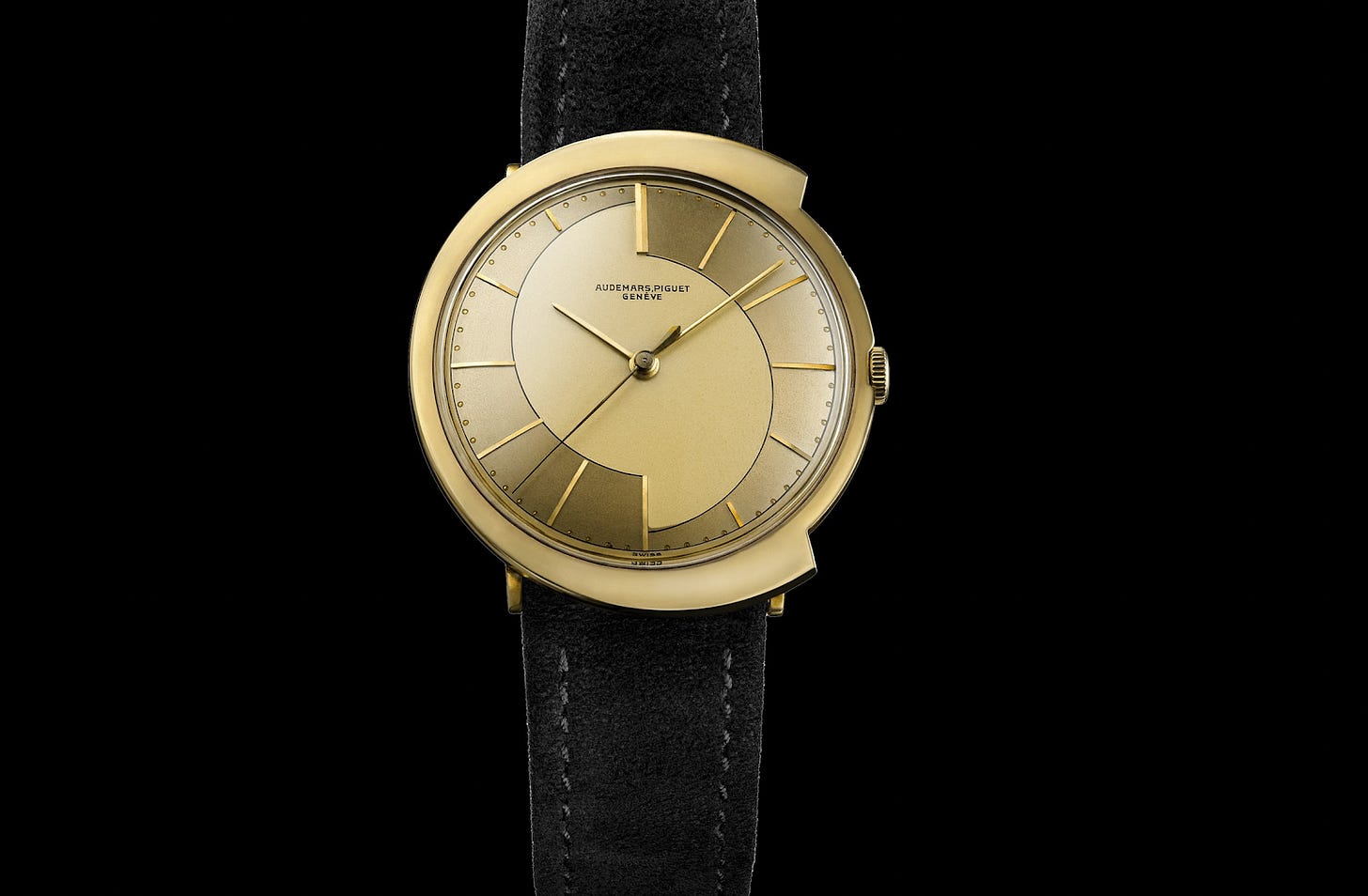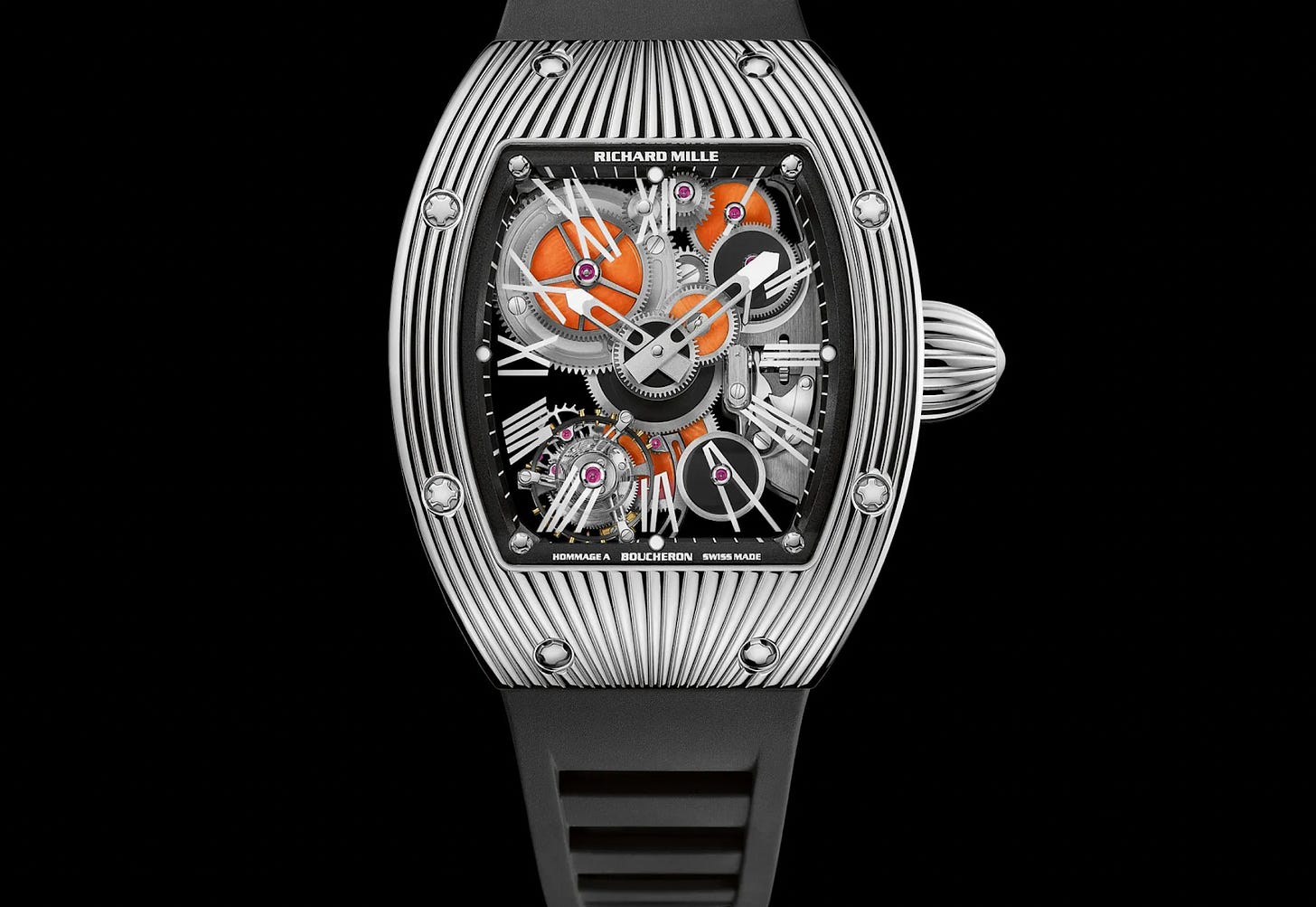The aesthetic codes of architectural styles are often found in the design of watches. The correspondence between the two, architectural styles and watch design, becomes obvious in the use of similar lines and shapes, proportions, materials, and decorative elements.
Take for example classical, Art Deco, and Bauhaus architectural styles. Classical architecture emphasizes balanced and harmonious proportions and symmetrical arrangements in building facades and layouts, design features which are ubiquitous in vintage and modern watches. Examples abound. Afterall, the impression of visual symmetry has always been a guiding principle in watchmaking.
The Patek Philippe Calatrava line is a very good example of a perfectly balanced and symmetrical dial, in a round watch. The placement of hour markers, hands, and any subdials or complications are precisely arranged to ensure visual harmony.
Art Deco was a style that emerged in Europe and in the United States in the 1920s and 1930s. It introduced the idea of decorative styles based on strong angular geometric shapes, bold lines, and repetitive patterns. Some notable examples of this style can be found in vintage watches from Jaeger LeCoultre, Hamilton, Elgin and, more recently, Richard Mille.
Bauhaus style was founded in 1919 with the establishment of the Bauhaus school in Weimar, Germany. The Bauhaus style emphasizes simplicity and functionalism. Two relevant examples of brands that have adopted this style are Nomos Glashutte and Junghans.
An interesting parallel can be found between Gothic architectural style and some of the aesthetic codes in Breguet and Greuble Forsey watches. To illustrate, refer to the arrangements of arcs, bridges, together with the sophisticated guillochage in the Breguet Tradition 7077, and the angular elongate bridges and pointed hands in Greubel Forsey’s Balancier 3.
The designs in these watches are reminiscent of the pointed arches, flying buttresses, intricate design, and the blend of functional innovation with aesthetic beauty that was the essence of Gothic architecture.
The following three watches have timeless appeal and are some of the best examples of the similarities between watch design and architectural styles inspired by artistic movements of the 20th century.
The Audemars Piguet Asymmetrical Watch
The Audemars Piguet model 5182 was an experimental watch created in 1962. Its design draws inspiration from both Modern and Space Age architectural styles of the middle of the 20th century, which introduced innovative designs and futuristic aesthetics.
The influence of the Modern style on the watch is evident in its simple yet sophisticated design, together with an emphasis on the essential elements of timekeeping, and the absence of unnecessary decorations.
The asymmetrical case and dial reflect an avant-garde design, an expression of futuristic and forward-looking codes, which was typical of the Space Age style.
To illustrate, the interaction between curves and lines, different color tones, and alternating satin-brushed, polished, and grained surfaces, accentuates the asymmetric design of the watch. Furthermore, the bezel has a different shape and is thinner on the right half of the case.
In the dial, the length of the hour indices gradually decreases between 12 and 5 o’clock and this is repeated between 6 and 11 o’clock. These patterns are enclosed inside a mask colored in yellow, of a darker tone than the rest of the dial (case and dial are 18-carat gold), and bordered by solid black lines. The whole is reminiscent of a helix.
The contrapposing patterns of the hour indices create a second asymmetry in the middle of the dial, where two halves of a circle are misaligned along the vertical diameter, one half being higher than the other.
There is simplicity in the whole design of the watch, yet the eye and the mind need to be engaged to interpret it. Finally, the crown and the lugs are clearly designed with a size that does not distract the eye from contemplating the asymmetries in the rest of the watch.
Fig. 1 - The Audemars Piguet Asymmetric Watch (1962)
The Richard Mille RM018 Tourbillon
Launched in 2008, the RM018 is an example of the application of Art Deco aesthetic codes. The Art Deco is a decorative style that flourished between the two world wars. It originated in France and it acquired international attention at the 1925 international Exhibition of Decorative Arts held in Paris.
Some of its more important features are the use of strong angular geometric shapes, bold lines, repetitive and symmetrical patterns, in order to create a striking visual impact.
It aimed at creating elegance and sophistication; its main thesis was decorative arts as an art form opposed to the Machine Age standardization, which sacrificed aesthetic beauty in favor of mass production. The style had great influence on architecture, especially in the United States.
The case of the RM018 is tonneau-shaped, also described as a rounded-rectangular shape. In a clear connection with Art Deco architectural patterns, the RM018 case features deeply engraved vertical ridges, creating a frame around the open dial and skeletonized movement. Similar patterns can be seen on the Chrysler Building, the Empire State Building, and the Niagara Mohawk Building in New York.
The vertical ridges, the open dial and skeleton movement, and the case curvature enhance the visual three-dimensional look of the watch. Several wheels in the movement are colored, depending on the type of precious stones used, adding further visual depth to the movement.
The crown repeats the engraving of the ridges but horizontally, in sharp contrast with the vertical ridges on the front of the case. The case, crown, and ridges are metal-colored, silver like, which is also a characteristic of the Art Deco style. They are reminiscent of the Art Deco Streamliner trains of the 1930s.
Fig. 2 - The Richard Mille RM018 Tourbillon
Junghans’ Max Bill Automatic Bauhaus
The watch was first launched in 1961. But it has gone through several reiterations, since then. Its design reflects the aesthetic codes of the Bauhaus movement, which is considered to be one of the most influential artistic movements of the 20th century. It had a profound influence on various design disciplines such as watchmaking, architecture, and furniture. Two examples of architectural Bauhaus icons are the Farnsworth House in Chicago and the Villa Tugendhat in Brno, Czech Republic.
The Bauhaus style emphasized simplicity and functionality. Its influence on the design of watches is reflected in a minimalistic and pragmatic design, ensuring that the watches remain relevant through time.
The Max Bill Automatic Bauhaus is a perfect example of this style. The watch features a clear lack of unnecessary decorative elements or sophistication in its design. The bezel is thin, practically absent, to allow for a full display of the dial.
There is no information clutter in the dial. In fact, it features only the strictly necessary amount of information to read the time. Simple thin indices and slender hands do not impose on the look of the dial. There is a minimal use of color to increase the eligibility of the hands and the date function. And the crown and the lugs are small and in proportion with the case, thus not disturbing the whole visual balance of the watch.
Fig. 3 - The Junghan’s Max Bill Automatic Bauhaus





